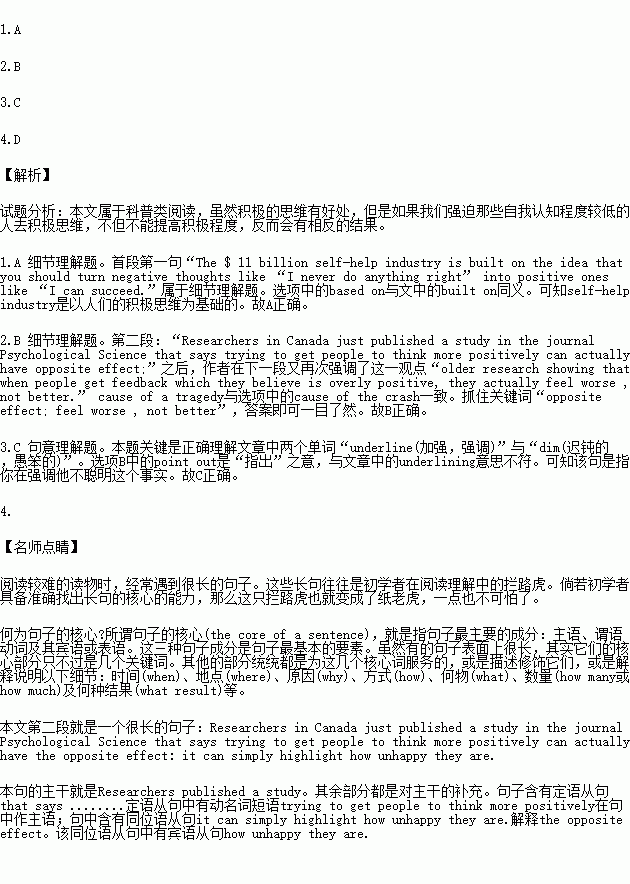题目内容
The $ 11 billion self – help industry is built on the idea that you should turn negative thoughts like “I never do anything right” into positive ones like “I can succeed.” But was positive thinking advocate Norman Vincent Peale right? Is there power in positive thinking?
Researchers in Canada just published a study in the journal Psychological Science that says trying to get people to think more positively can actually have the opposite effect: it can simply highlight how unhappy they are.
The study's authors, Joanne Wood and John Lee of the University of Waterloo and Elaine Perunovic of the University of New Brunswick, begin by citing older research showing that when people get feedback which they believe is overly positive, they actually feel worse, not better. If you tell your dim friend that he has the potential of an Einstein, you're just underlining his faults.
In one 1990s experiment, a team including psychologist Joel Cooper of Princeton asked participants to write essays opposing funding for the disabled. When the essayists were later praised for their sympathy, they felt even worse about what they had written.
In this experiment, Wood, Lee and Perunovic measured 68 students' self-esteem. The participants were then asked to write down their thoughts and feelings for four minutes. Every 15 seconds, one group of students heard a bell. When it rang, they were supposed to tell themselves, "I am lovable."
Those with low self-esteem didn't feel better after the forced self-affirmation. In fact, their moods turned significantly darker than those of members of the control group, who weren't urged to think positive thoughts.
The paper provides support for newer forms of psychotherapy (心理治疗) that urge people to accept their negative thoughts and feelings rather than fight them. In the fighting, we not only often fail but can make things worse. Meditation (静思) techniques, in contrast, can teach people to put their shortcomings into a larger, more realistic perspective. Call it the power of negative thinking.
1.What do we learn from the first paragraph about the self-help industry?
A. It is based on the concept of positive thinking.
B. It is a highly profitable industry.
C. It was established by Norman Vincent Peale.
D. It has produced positive results.
2.What is the finding of the Canadian researchers?
A. There can be no simple treatment for psychological problems.
B. Encouraging positive thinking may do more harm than good.
C. Unhappy people cannot think positively.
D. The power of positive thinking is limited.
3.What does the author mean by “you're just underlining his faults” in the third paragraph?
A. You are not taking his mistakes seriously enough.
B. You are pointing out the errors he has made.
C. You are emphasizing the fact that he is not intelligent.
D. You are trying to make him feel better about his faults.
4.It can be inferred from the experiment of Wood, Lee and Perunovic that .
A. it is important for people to continually keep their self - esteem
B. self-affirmation can bring a positive change to one’s mood
C. people with low self-esteem seldom write down their true feelings
D. forcing a person to think positive thoughts may lower their self-esteem


 ),并在其下面写出该加的词。
),并在其下面写出该加的词。